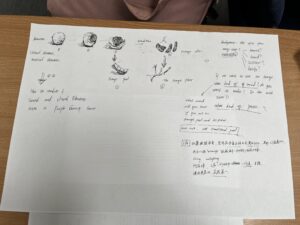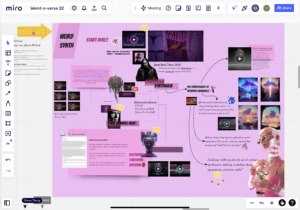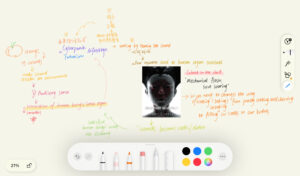For this week’s group work, our group was assigned the score topic of oranges and after learning about the 25 methodologies, we got to work.
The idea was to implement the methodology of peeling oranges into slices and letting passers-by eat them, and based on their feedback to explore the art projects that could be developed. However, after a short experiment, we did not get very good feedback from the passers-by, who only gave us us useless feedback, such as: the oranges were sweet, the oranges were tasty. So we abandoned this direction for the time being. After a short period of reflection, we realised that this approach was too one-dimensional in terms of the user experience, because if we wanted to target everyone, we would have to focus more on the experience of our art projects, because passers-by might not be art practitioners and the feedback they gave us in a short period of time might only be from the ordinary sensory touch, which is not the score we need. So my idea is that maybe we need a score that is more of an art or design experience.


In the second thinking phase, I think I used critical thinking education and constructivist thinking to develop our group’s ‘oranges’. Firstly, the 25 methodologies inspired me about how to construct different sequences, so I drew some sketches about eating oranges, divided into the original orange, peeled orange, simple orange, peeled orange and orange fibre, and then I started to imagine whether we could eat oranges in other ways or ways, perhaps with our mouths? With our hands? Maybe with the brain? Or maybe with another part of the body or organ? After a lot of thought, I decided that the “listening” method could be developed and practised, but how do we measure the listening method? My initial idea was to record the sounds of the six parts of the orange as an auditory element. The next question was the process of eating the oranges, in what order do we eat them, how do we create this score and what kind of process is unique? After a brief sketch I shared my ideas with the group and with their unanimous approval and agreement we intended to use this as the initial direction for our group.

Afterwards we presented our direction to our supervisor, Jake, who gave us some very useful advice: 1. we need to think about what each part of the orange sounds like, not just any traditional sound, but what it sounds like. 2. if it is a recording, we need to think about what we will encounter in the recording process and what the value of it is, and we can also change the We could also replace “orange” with other material or research objects. 3. Our project is a bit thin at the moment and needs to be supported by a large set of values. Finally, Jake urged us to put theory second and practice first.
And how do you achieve the shift in thinking from listening to oranges to eating them? I thought back to my WEIRD research last week.

Again, it was an exploration of sound and a vision for the future (how to move from eating food to listening to food), so I shared my ideas with the group and after some discussion we adopted the idea of another group member besides me, which was sound therapy, but we felt that sound therapy was not as innovative, exploratory and serendipitous as it could be and was not well suited to our course of study, so after discussion we intended to use the general context as a futuristic punk style, transforming oranges into data sounds to meet the hunger needs of being a future human.

We intended to create a UI interactive interface with 6 audio buttons about oranges, where the viewer could experience the future way of eating oranges, with no score, and it was up to the viewer to ‘eat’ them in whatever order they wanted.
We chose six types of audio: peeling an orange, peeling an orange, tearing an orange fibre, a human chewing an orange and an animal chewing an orange.
All the original images and audio resources for the project were collected by the team members.
The team member, Jia Ding, used a synthesiser to process them into a perturbator with an electronic and crushing feel.
I drew out six audio icons and logos.

Team member Ziqian Zhang created the UI interaction interface.
Team member Lee Siree Wang edited the concept video with me.
Zeikun Yang, Jianhao Lai and Yinan Liu are responsible for rationalising the concept and logic of the project, as well as copy-editing.
For the project, I think there is a lot more we can do, in fact, at the moment, the way the sound is made through a simple interactive page button is still a little bit unconventional, because the audience is only combining the audio, it is still a little bit less interactive and experiential, if we want to further improve the project I think we can start from a programming point of view, for example, we can write a program and let the audience to transform the For example, we could write a code that allows the audience to post the audio they want to transform into the system, and then the system could transform it into the user’s own unique ‘food’, which would be more experiential.
In this project, I think our team members were able to find their own niche, the team members from the design background were able to brainstorm and design output well, the team members from the choreography background were able to handle the audio well, the team members from the literature and media background were able to sort out the project logic and copy-editing well, and we had a very good team atmosphere where we respected each other, completed tasks on time, and were able to work well together across disciplines. I feel that this experience has taught me a lot and will provide me with a lot of experience in my future work and study life.


In Tianxing Peng’s article, I learned his idea about PLAY – Orange in our group very well. I think it is important because we actually complete the task together as a whole. In this process, each of us is responsible for different parts. Even though the research object is the same orange, our understanding of orange and feedback on PLAY practice are different in the research process, His content makes me find that he integrates PLAY into the art creation of the future world of mankind from the perspective of the stream of consciousness, which is very good.
This blog is very in-depth, and I found a lot of points worth learning and in-depth research from the blogger’s articles. Throughout the process, bloggers can be seen in earnest study and participation.
In this blog, the authors share their Basho’s process for completing the content of this group assignment. I was very impressed by their group work, they added philosophical thinking to the score of eating oranges and made a very interesting interaction. So I am looking forward to seeing their thinking and completion process. Thanks to the author for sharing. He provided me with more direction to think and develop for the subsequent learning process.
The shift in thinking from listening to oranges to eating oranges? This is something that a person with my lack of imagination did not expect.
I associate it with the medical approach to plant healing, but that already exists, and the author’s is more futuristic with innovative serendipity. Suitable for our group to explore, the last blog of mine commented that he began to use WEIRD thinking very well, as reflected here in Orange. Gives a general context in which the future can be punked, transforming oranges into data sound code for human feeding needs.
I saw that you made some sketches about oranges, from the complete orange to plucking the skin to the fibres of the orange, so that you gradually analysed them bit by bit. Then I also saw that you kept asking yourself questions throughout the learning process, such as “how do you achieve the shift in thinking from listening to oranges to eating them?” which is a good reflection process. I think it’s a good reflection process and I think it helps us to learn and reflect. I also saw that you had written out in detail the division of labour and cooperation in your team and it was really good to see that your group’s tasks were clear and well defined and that everyone was working together. I think I can also learn from you when I write my next reflection and ask myself more questions.
Tianxing Peng, this is an excellent blog post and great example how to provide a critical post-rationalisation of practice-led group research while also providing contextual information to aid the reader’s understanding of not only what happened, how it happened but also why. I think this approach to articulating research will stand you in good stead for later in the course.
You are correct to identify constructivist frameworks as the model through which you were developing this form of project articulation and you did well to attribute your peers’ contributions to the overall development of the work. An associated research method that you are all in-effect enacting is critical participatory action research’ and you may want to read into this model further to understand at a metacognitive level how your intersecting practices informed and developed one another during your playing together -> https://discovered.ed.ac.uk/permalink/44UOE_INST/1viuo5v/cdi_askewsholts_vlebooks_9789814560672
The detailed pictures and process of your group work was impressive 🙂
I really like the way you organised that assignment in this blog, which looks very clear and was interesting to read. It’s like watching a documentary.
And you also demonstrated great ability to connect this group work and the theories.